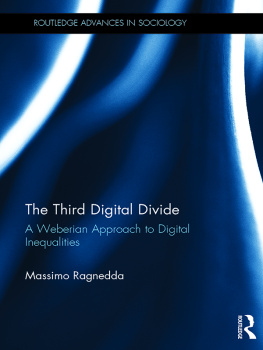Stratification in Israel
Volume Editors
Moshe Semyonov, Tel-Aviv University
Noah Lewin-Epstein, Tel-Aviv University
Editorial Board
Eliezer Ben-Rafael, Tel-Aviv University
Shlomo Deshen, Tel-Aviv University
Eva Etzioni-Halevy, Bar-Ilan University
Elihu Katz, Hebrew University of Jerusalem
Ernest Krausz, Bar-Ilan University
Yochanan Peres, Tel-Aviv University
MenachemRosner, Haifa University
Itzhak Samuel, Haifa University
Judith T. Shuval, Hebrew University of Jerusalem
First published 2004 by Israel Sociological Society and Transaction Publishers
Published 2017 by Routledge
2 Park Square, Milton Park, Abingdon, Oxon OX14 4RN
711 Third Avenue, New York, NY 10017, USA
Routledge is an imprint of the Taylor & Francis Group, an inform a business
Copyright 2004 by Israel Sociological Society.
Sponsored by the Schnitzer Foundation for Research on the Israeli Economy and Society-Bar-Ilan University.
All rights reserved. No part of this book may be reprinted or reproduced or utilised in any form or by any electronic, mechanical, or other means, now known or hereafter invented, including photocopying and recording, or in any information storage or retrieval system, without permission in writing from the publishers.
Notice:
Product or corporate names may be trademarks or registered trademarks, and are used only for identification and explanation without intent to infringe.
Library of Congress Catalog Number: 2003056525
Library of Congress Cataloging-in-Publication Data
Stratification in Israel: class, ethnicity, and gender / Moshe Semyonov and Noah Le win-Epstein, editors.
p. cm. (Studies of Israeli society; v. 10)
Articles originally published 1990-2001.
Includes bibliographical references.
ISBN 0-7658-0199-X (cloth : alk. paper) ISBN 0-7658-0801-3 (pbk.: alk. paper)
1. Social stratificationIsrael. 2. Social classesIsrael. 3. Ethnic groupsIsrael. 4. EqualityIsrael. 5. IsraelSocial conditions. I. Semyonov, Moshe. II. Le win-Epstein, Noah. III. Series.
HN660.A57 v. 10
[HN660.A57]
305.095694-dc22
2003056525
ISSN: 0734-4937
ISBN 13: 978-0-7658-0199-9 (hbk)
ISBN 13: 978-0-7658-0801-1 (pbk)
We wish to gratefully acknowledge the permission to use copyrighted material granted by journals and publishers.
is reprinted from Ethnic and Racial Studies, 1998, vol. 21, no. 3, pp. 507528, with permission from Taylor & Francis Ltd. http://www.tandf.co.uk. Copyright 1998 by Routledge.
is reprinted from the American Sociological Review, February 1990, vol. 55, pp. 115126, with permission of the publisher.
is reprinted from Research in Sociology of Education and Socialization, 1996, vol. 11, pp. 233261, with permission from Elsevier Science. Copyright 1996 by JAI Press Inc.
is reprinted from British Educational Research Journal, 1999, vol. 25, no. 3, pp. 355370. Copyright 1999 with permission from British Educational Research Association.
is reprinted from British Journal of Sociology, 1992, vol. 43, no. 2, pp. 225237, with permission from Taylor & Francis Ltd. http://www.tandf.co.uk.
is reprinted from Research in Stratification and Mobility, 1997, vol. 15, pp. 328, with permission from Elsevier Science. Copyright- 1997 by JAI Press Inc.
is reprinted from the Journal of Rural Cooperation, 1999, vol. 27, no. 2, pp. 117127, with permission of the publisher.
is reprinted from Social Indicators Research, 2001, vol. 54, pp. 115137. Copyright 2001 with permission from Kluwer Academic Publishers.
is reprinted from Comparative Studies in Society and History, 1996, vol. 38, pp. 243266, with permission from Cambridge University Press. Copyright 1996 by Society for Comparative Study of Society and History.
is reprinted from British Journal of Sociology, 2000, vol. 51, no. 3, pp. 525551, with permission from Taylor & Francis Ltd. http://www.tandf.co.uk. Copyright 2000 by London School of Economics and Political Science.
is reprinted from Sociology, 1995, vol. 29, no. 3, pp. 429451. Copyright 1995 with permission from Cambridge University Press.
is reprinted from Social Problems, 2000, vol. 47, no. 1, pp. 4967, with permission from University of California Press. Copyright 2000 by Society for the Study of Social Problems, Inc.
is reprinted from Israel Social Science Research, 1997, vol. 12, no. 1, pp. 129166, with permission of the publisher.
is reprinted from Sex Roles, 1998, vol. 39, no. 12, pp. 855872. Copyright 1998 with permission from Plenum Publishing Corporation.
is reprinted from Research in Stratification and Mobility, 1997, vol. 15, pp. 133149, with permission from Elsevier Science. Copyright 1997 by JAI Press Inc.
is reprinted from Israel Social Science Research, 1996, vol. 12, no. 1, pp. 93108, with permission of the publisher.
is reprinted from Ethnic and Racial Studies, 1998, vol. 21, no. 3, pp. 408427, with permission of the publisher.
is reprinted from Urban Studies, 1993, vol. 30, no.l, pp. 157182, with permission of the publisher.
is reprinted from Social Problems, 2000, vol. 47, no. 3, pp. 425444, with permission from University of California Press. Copyright 2000 by Society for the Study of Social Problems, Inc.
This volume would not have been completed without the dedicated help of Tal Spaltes, Asaf Levanon, Tamar Reinfeld, and Sylvia Weinberg. We are grateful for their assistance. We would also like to thank Anne Schneider for her careful and very helpful editing.





